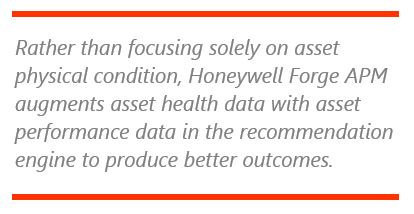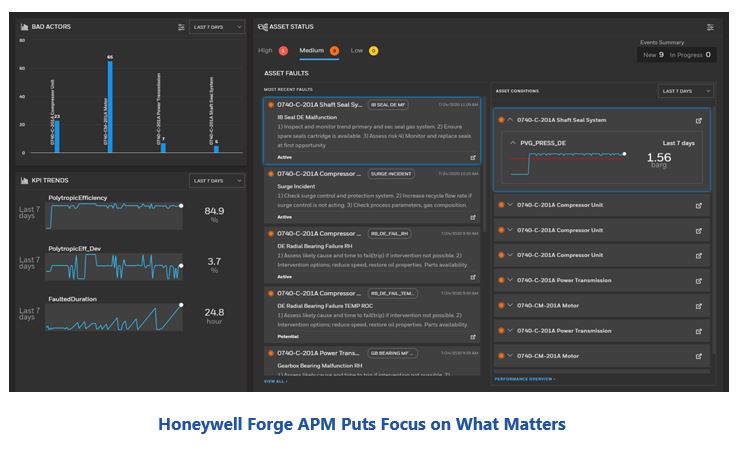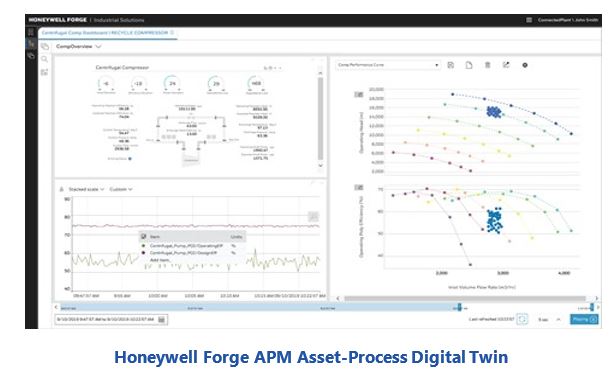

Honeywell Forge APM (Asset Performance Management) merges machine modeling with analytics and digital twins to increase machinery availability, identify inefficient operation, and improve reliability and maintenance 
Product managers R. Ilangovan and Garrett Rysko recently briefed ARC Advisory Group analysts on this new tool in the Honeywell Forge Enterprise Performance Management (EPM) toolbox. This suite of industrial-focused applications is specifically designed to collect, unify, and act on operational data to help optimize performance, sustainability, and safety at the enterprise level. Rather than focusing solely on asset physical condition, Honeywell Forge APM utilizes asset health data augmented by asset performance data in its recommendation engine for better outcomes.
Key findings include:
At this stage of APM solution maturity, the findings of an ARC survey of end users conducted in early 2019 to gain a better understanding of how industry leaders are implementing APM initiatives and compare the effectiveness of different approaches was revealing. Survey results indicated a belief that operations have as much impact on plant and asset performance as the maintenance organization. Yet, historically, APM has been a maintenance-focused activity.
ARC believes that successful APM requires tools that enable close collaboration among the maintenance, reliability, process engineering, and operations functions; and that digitalization is the key to moving the APM needle.

Another revealing response indicated two-thirds of respondents did not believe reliability-centered maintenance (RCM) is improving reliability. While higher asset availability was cited as the most valued benefit of APM, many systems still appear to lack the ability to issue asset breakdown warnings far enough in advance to be of value.
Consider this example from a paper industry speaker at ARC’s 2020 Industry Forum in Orlando. Each time a grade change was made to a process, the pump “was getting killed.” Analysis of pump vibration data alone did not reveal the issue, requiring the pump to be replaced every year during a planned outage. However, by analyzing operations, process, and vibration data and visualizing these analyses in context, the problem become instantly clear. Implementing a minor change to that process solved the recurring problem. A small win like this became a big one when implemented across 150 manufacturing sites for this owner/operator.

The above example perfectly captures the need and effectiveness for what Honeywell calls an “asset-process digital twin” that combines data from historians as well as the key processed data of expert methods. A combined twin enables both domain experts and automated analytic engines to draw from an improved, high-quality dataset for recognizing new improvement opportunities and more readily predict impending production threats with enough time to employ corrective measures. As the example demonstrated, the combined twins can provide the context needed to make an issue instantly clear. This can provide a powerful and compelling advantage. Adequate time to make corrective actions meaningful is critical as borne out by ARC’s survey findings.
According to the company, a century’s worth of patents and technologies that support reliable and safe operation of equipment and processes in the heavier process manufacturing industries is embedded into Honeywell Forge APM. By including this rich trove of subject matter expertise into its models, Honeywell has essentially democratized analytics for use by engineers (rather than data scientists).
At its core, Honeywell Forge APM is a cloud-based/on-prem asset health software solution designed to enable and sustain operational excellence. The unified environment integrates operational, engineering, and maintenance workflows to help ensure availability of the best information on which to make recommendations for corrective action. ARC believes this unification will lead to better outcomes and speed time-to-value. Pre-built templates enable scalability and drive standardization across the enterprise to help ensure recommended actions are implemented appropriately and accelerate time to value.
When assets don’t perform to expectations or exhibit the anticipated reliability, profit margins suffer and operational excellence becomes elusive. Owner/operators have long suspected that poor asset performance hampers overall business performance. Recent ARC research indicates that while both maintenance and operations groups have a major impact on overall asset performance, historically, the practice of APM has not taken a holistic approach. The research also indicates that successful APM requires close cooperation among the maintenance, reliability, process engineering, and operations functions.
When it comes to APM, many end users continue to focus on the technology, without considering the full organizational impact. The holistic modeling approach of Honeywell Forge APM enables owner/operators to utilize the more meaningful target of availability to plan, meaning the asset runs when it’s supposed to run, by assessing the cost consequences of corrective actions. Utilizing data to plan and schedule maintenance activities according to highest value opportunities ensures the manufacturing process remains under control.
ARC Advisory Group clients can view the complete report at ARC Client Portal
If you would like to buy this report or obtain information about how to become a client, please Contact Us
Keywords: Asset Performance Management (APM), Honeywell Forge, Operational Excellence (OpEx), Reliability-centered Maintenance (RCM), Analytics, ARC Advisory Group.

